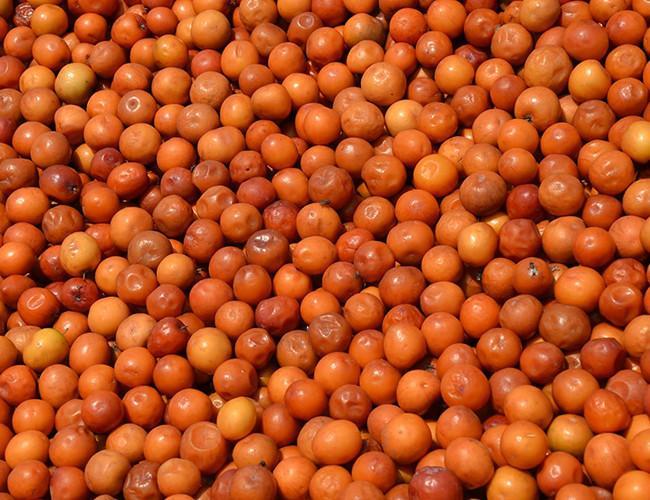
The fruit of the plant genus “Ziziphus” is always a short-lived delight in the fall. In Turkey, it appeals to a great range of people, children and elderly in particular. Children like it (or once liked it) as an amusing snack. The elderly like it more for health reasons, as it has been considered a cure for many geriatric problems, such as high blood pressure, diabetes, cognitive deficiencies and above all, high cholesterol. It is like having the whole pharmacy in a single fruit. Actually, I’m not sure if today’s children enjoy it anymore as we did once. They have such diverse choices that they no longer care for the odd tastes of our childhood, and Ziziphus fruit is indeed quite odd.
We are talking about “jujube,” the fruit more commonly known as the Chinese date. The definite origin of the tree is unknown. It could either be China or Syria, the fruit is also known as the Korean date and the Indian date. It is known in many Asian countries, where different varieties yield fruits as big as plums, apricots or walnuts. In Turkey, the typical ones could be as small as olives and look really similar, while the biggest ones are as large as dates.
Though traditional, most people in Turkey do not know much about it, although it has been around for ages. In Turkish, jujube is called “hünnap,” or depending on the region, “innap,” or “ünnap,” coming from the Arabic “innap.” Jujube was one of the favorite fruit preserves at Topkapı Palace, where there was a special kitchen for jam-making known as a “reçelhane.” It is known jujube was used for medicinal purposes in antiquity in Syria.
One speculation is the thorny wreath of Jesus was made from the spiky branches of the jujube tree. In depictions, the jujube fruit can easily be mistaken for an olive or a date, both biblical holy fruits. There is also another suggestion that what the “lotus-eaters” described by Homer in the Odyssey had been consuming that caused lethargy and forgetfulness was jujubes, not that it has narcotic properties, but it does have the potential to ferment producing a potent alcohol.
Well, this alone makes the jujube, the odd fruit of Asia and Asia Minor alike, worth exploring!
Recipe of the Week: In Italy, there is a drink called “Brodo di Giuggiole,” which translates as “Jujube Broth.” It is even better if matured for a month or two, so jujube season is just right to have it ready by Christmas. There is a saying in Italian, “andare in brodo di giuggiole,” which means “to be over the moon,” explaining the effects of the concoction.
Here is one method: Take 1 kg ripe jujube, 2 quinces and 2 bundles of Muscat grapes or any fragrant aromatic grapes. Cut the quinces in pieces, stalk the grapes, but all in a large preserving pot with 1 kg. sugar and enough water to cover. Simmer for an hour or so, when the fruits are almost mushy, add two full glasses of wine (use white if you used white grapes, red if you used red grapes) and the zest of a lemon. Continue to simmer for another 20 minutes. When warm, strain through a muslin cloth and transfer into sterilized bottles, close tightly and keep in a cool and dark place.
Fork of the Week: Another health product to look for is jujube vinegar. Ask for “Hünnap Sirkesi” at your local spice shop. It can even be found even in pickle shops produced by regional producers, especially from the Antalya region.
Cork of the Week: Jujube has a crisp, lively appeal to it, spritely to the bite. It is zippy, zappy, zesty and fun to eat, quite similar to Asian pears and apples that have an extraordinary crunch, but not as juicy, on the contrary with a bit of a dry feeling in the mouth. The balance of faint sweetness is just right with acidity. I find crisp white wines go perfectly with it. My friend wine expert Mehmet Emin Türkat has come to my rescue again. He suggests Chamlija Riesling 2015, which I totally agree with. Here are his tasting notes: Expressing fresh green fruits of apple and pear, along with zesty lime. It starts to develop characteristic smoky, petrol-like notes of Riesling. High and refreshing acidity is in good balance with aromas, so just like a jujube! Actually, Chamlija Riesling might be your bone-dry white choice this season. The 2016 bottle received 88 points in the recent Third Thracian Wines Competition.